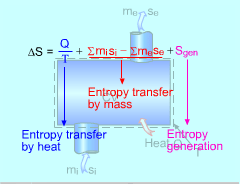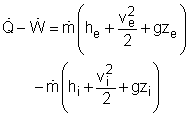| Ch 6. Entropy | Multimedia Engineering Thermodynamics | ||||||
| Entropy | Tds Relations |
Entropy Change |
Isentropic Process |
Isentropic Efficiency |
Entropy Balance (1) |
Entropy Balance (2) |
Reversible Work |
| Entropy Balance for Control Volume | Case Intro | Theory | Case Solution |
| Chapter |
| 1. Basics |
| 2. Pure Substances |
| 3. First Law |
| 4. Energy Analysis |
| 5. Second Law |
| 6. Entropy |
| 7. Exergy Analysis |
| 8. Gas Power Cyc |
| 9. Brayton Cycle |
| 10. Rankine Cycle |
| Appendix |
| Basic Math |
| Units |
| Thermo Tables |
| eBooks |
| Dynamics |
| Fluids |
| Math |
| Mechanics |
| Statics |
| Thermodynamics |
| ©Kurt Gramoll |
| |
||
| Entropy Balance for Control Volumes
| ||
 Entropy Transferred by Heat and Mass in Control Volume |
A control volume permits both energy and mass to flow through its boundaries. The entropy balance for a control volume undergoing a process 1-2 can be expressed as or in the rate form, as where i and e denote inlet and exit, respectively. The above entropy balance relation states that the
entropy change of a control volume undergoing a process 1-2 equals the sum of the entropy
transfer by heat, the net entropy transfer by mass, and the entropy generation in the control volume. |
|
| Analysis of a Control Volume at Steady State |  Propylene Flows Steadily through a Heat Exchanger |
Most control volumes encountered in practice, such as nozzles, turbines and compressors operate at steady state. Hence, there is no entropy change in the control volume. That is, The entropy balance in this case is In engineering analyses, the mass balance, energy balance, and the entropy balance often must be solved simultaneously. Recall, the mass balance and energy balance are, |
| One-inlet-one-exit Control Volumes | ||
 A one-inlet-one-exit Nozzle |
Many applications involve a one-inlet-one-exit control volume at steady state, such as a nozzle. The three balance equations for this case are, Mass Balance: Energy Balance: Entropy Balance: |
|



